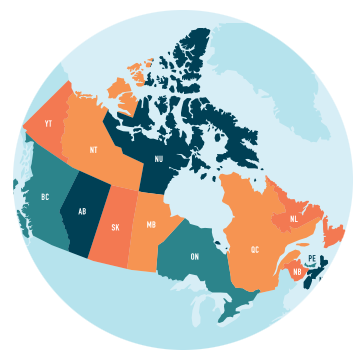Module 1: Professional Accountability and Prescribing
Lesson 3
Prescription Monitoring Programs across Canada
Links to prescription monitoring programs and resources by province/territory are provided below. This list is subject to change as programs evolve and participants are reminded to visit the provincial websites frequently to ensure they are viewing the latest versions of the programs.
The Tamper Resistance Pad Program facilitates safety in prescribing controlled drugs and substances by requiring prescribers to use a special prescription pad that cannot be altered without detection.
Currently, there is no formal monitoring system in place specifically for controlled drugs and substance,s but Prince Edward Island does have a Drug Information System (DIS), which gathers data on all prescription medications dispensed in the province. Originally limited to use by pharmacists, the system is now accessible by other healthcare providers. There is no specific mention of plans for monitoring controlled drugs and substances.
The Nova Scotia Prescription Monitoring Program (NSPMP) was created in 2005 under a provincial act and regulations; the goals are to promote the appropriate use of monitored drugs and reduce the abuse or misuse of monitored drugs in Nova Scotia. The program monitors controlled drugs and substances, including methadone, but with the exception of benzodiazepines, which are captured under the Drug Information System (DIS). Once the DIS is fully deployed in all pharmacies in the province, data from the NSPMP and DIS will be combined to give prescribers a complete profile of a patient’s prescription medications.
Similar to Nova Scotia, New Brunswick has both a prescription monitoring program and Drug Information System (DIS) which are targeted to be fully linked by November 2016. New Brunswick’s Prescription Monitoring Program (PMP) was created by a provincial act and regulations.
Related Resources:
Prescription monitoring in Ontario is part of the province’s Narcotic Strategy; defined by the Narcotics Safety and Awareness Act (2010) and operationalized in the Narcotics Monitoring System.
The Manitoba Prescribing Practices Program (M3P) defines the responsibilities of prescribers and pharmacists in prescribing and dispensing all medications including monitored controlled drugs and substances. More information about this program can be accessed at the College of Pharmacists of Manitoba website.
Saskatchewan’s Prescription Review Program (PRP) gathers data on drugs that have been identified as having potential for misuse or diversion. Information about the program can be accessed on the College of Physicians and Surgeons of Saskatchewan’s website.
Information about the PRP specific to NPs can be accessed on the Saskatchewan Registered Nurses Association website.
Alberta’s Triplicate Prescription Program (TPP) is a partnership of prescribers, government, and health authorities that is administered by the College of Physicians & Surgeons of Alberta. The program collects prescribing and dispensing data for specific drugs that are monitored in the province, and makes this information available to prescribers to support their decision making.
More information about the TPP can be accessed here.
The Prescription Review Program is administered by the College of Physicians and Surgeons of British Columbia and links to data gathered by the PharmaNet system.
Given the recent addition of controlled drugs and substances to NPs’ prescriptive authority in BC, many references do not specifically include NPs as prescribers for the purposes of these programs. Further information about NP linkages with the PRP can be accessed in the NP CDS Prescribing Resource Center on the CRNBC website.
